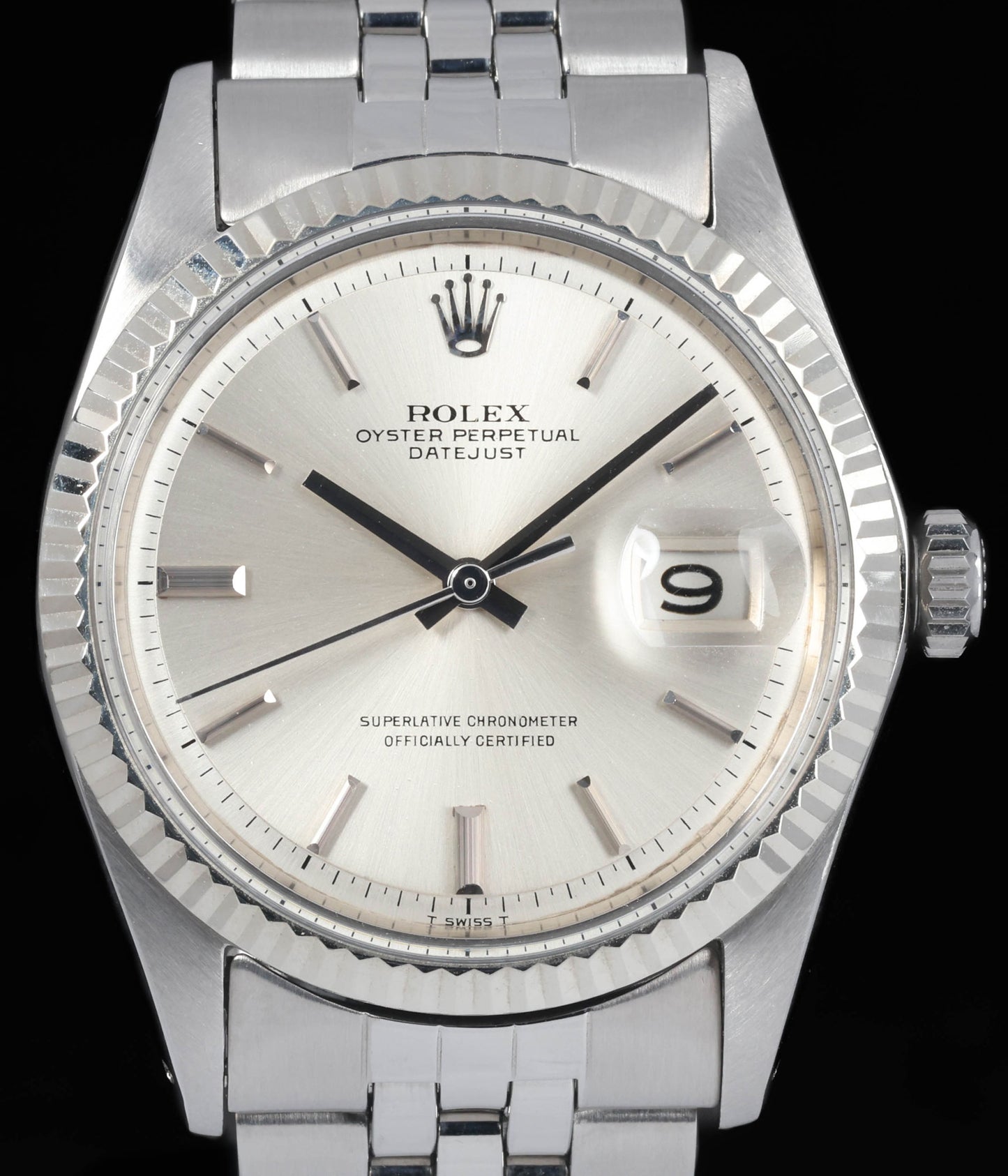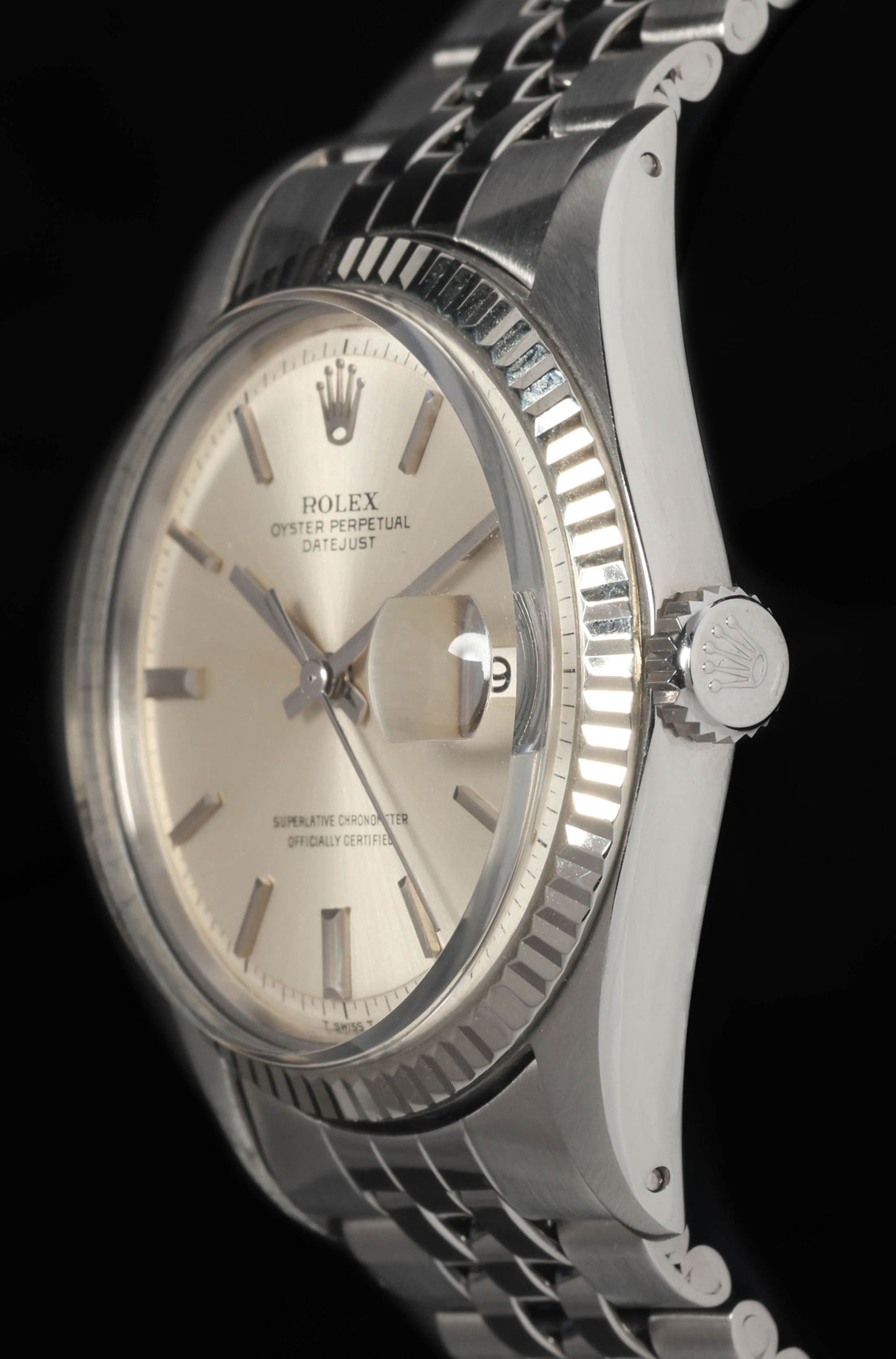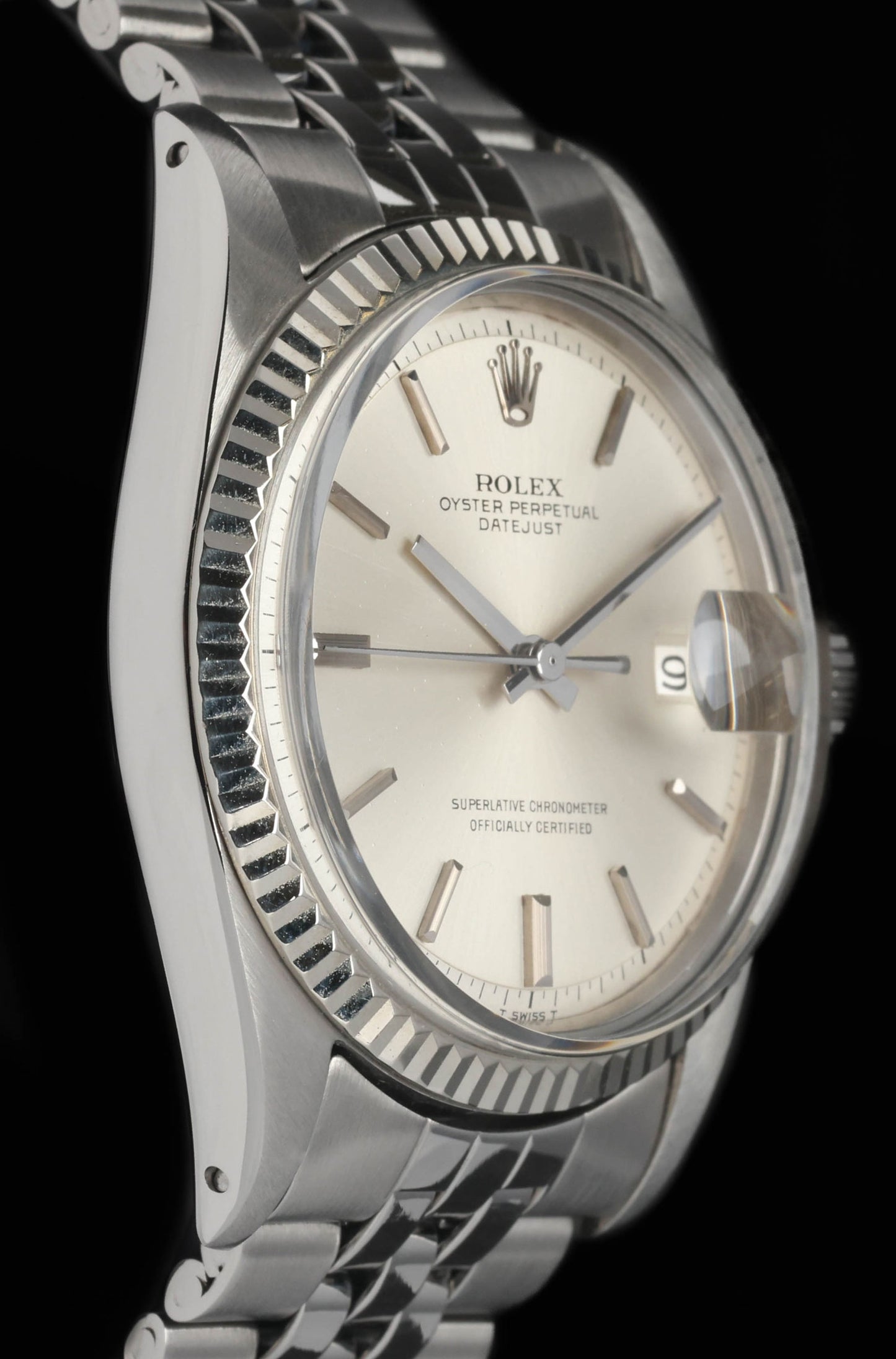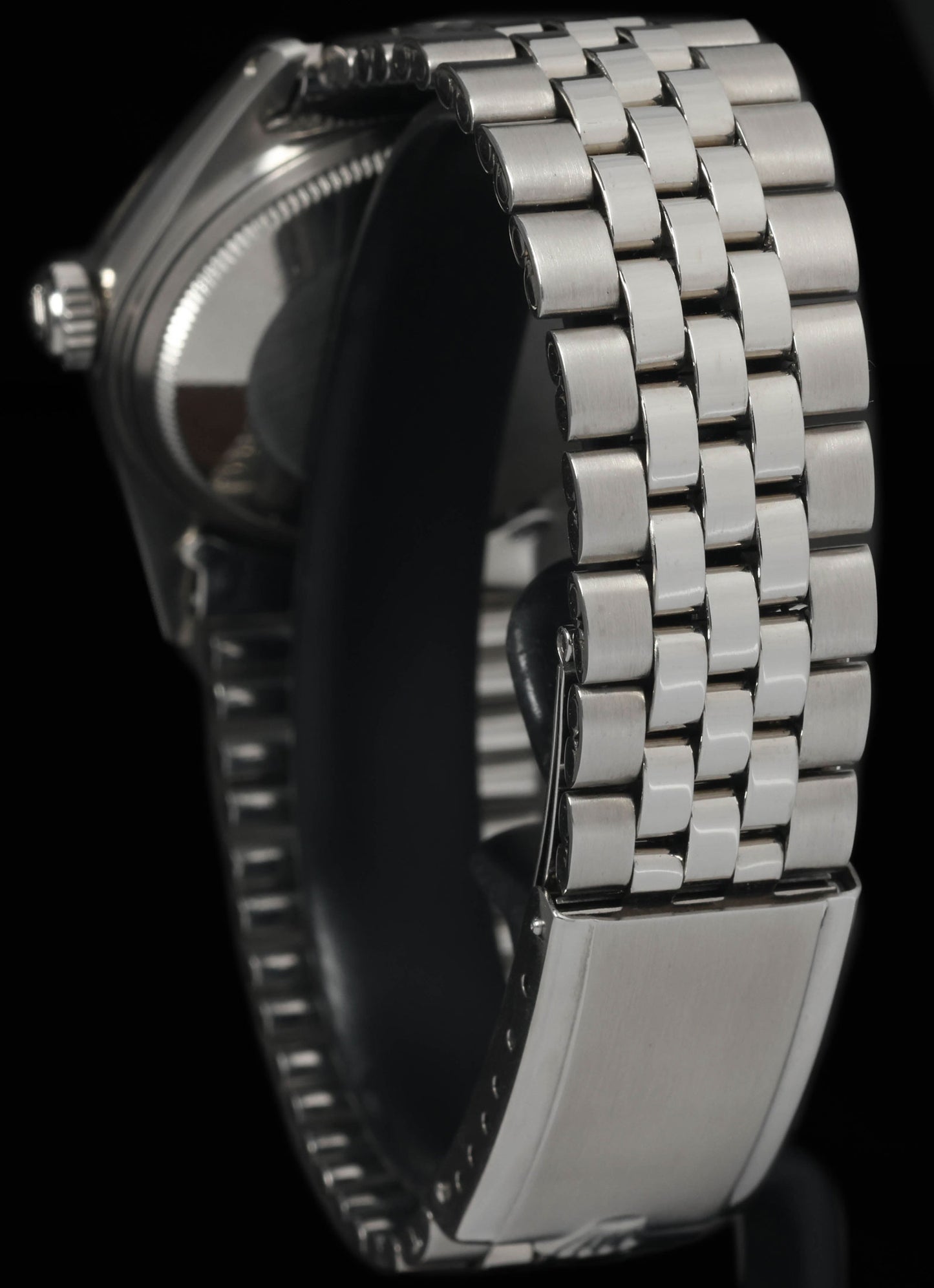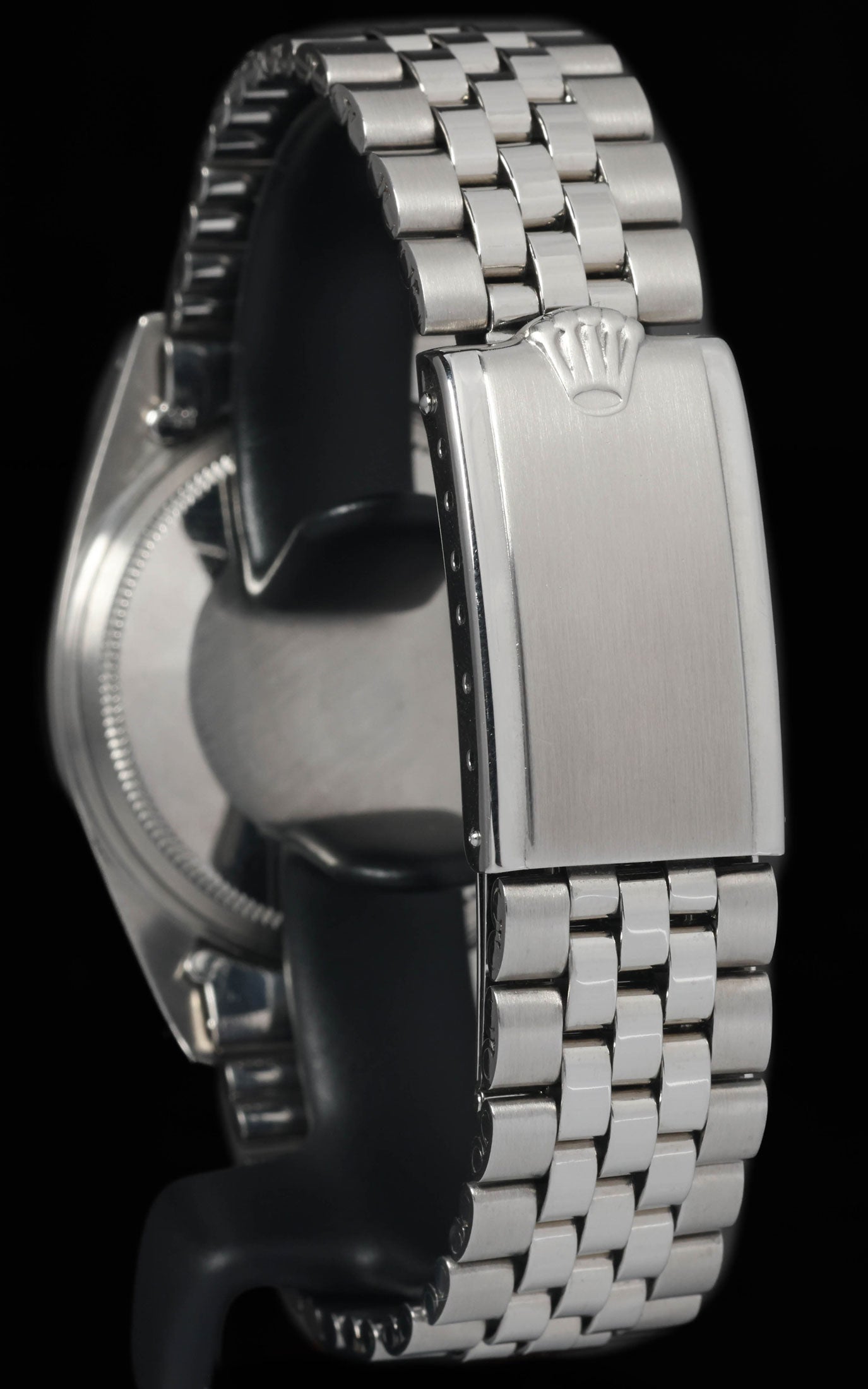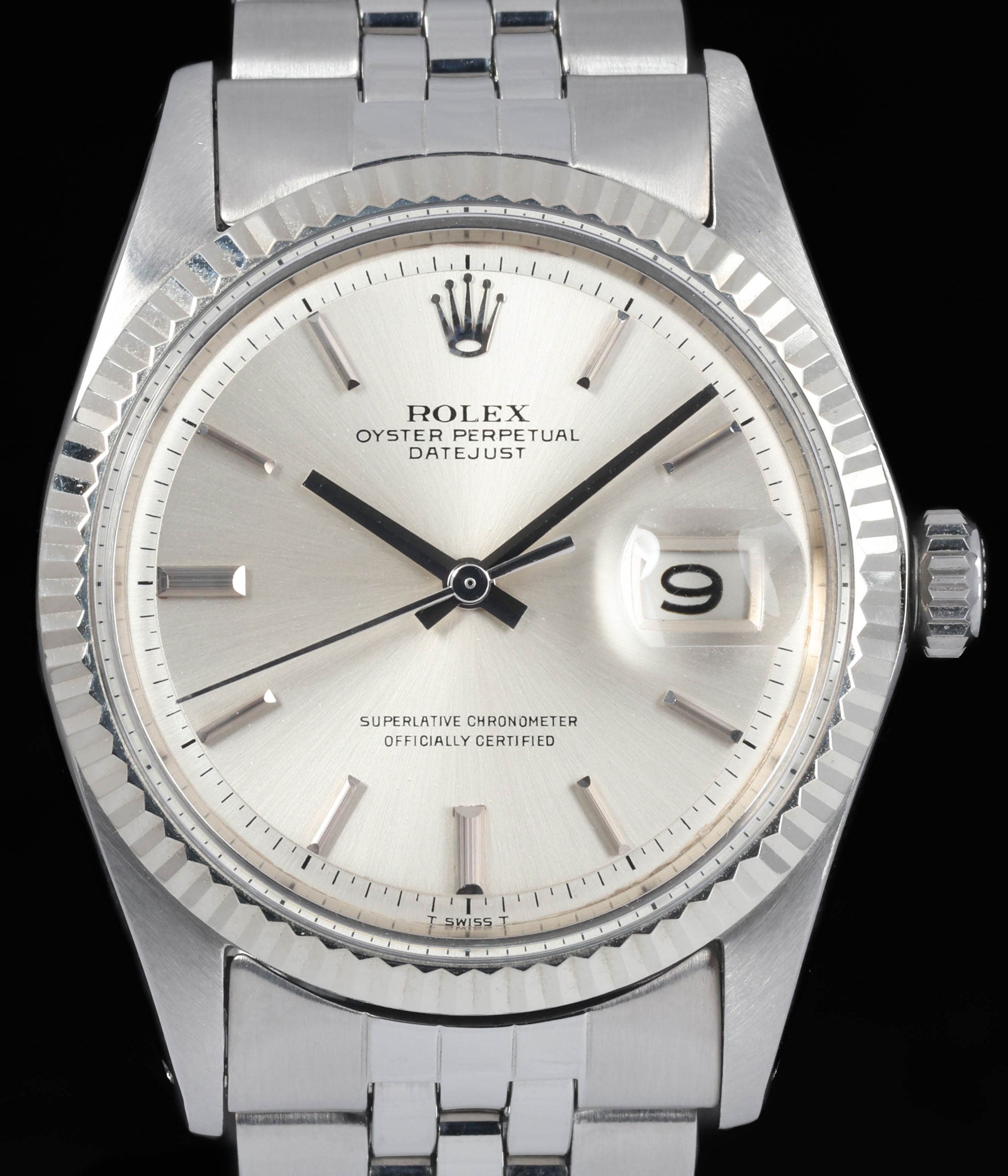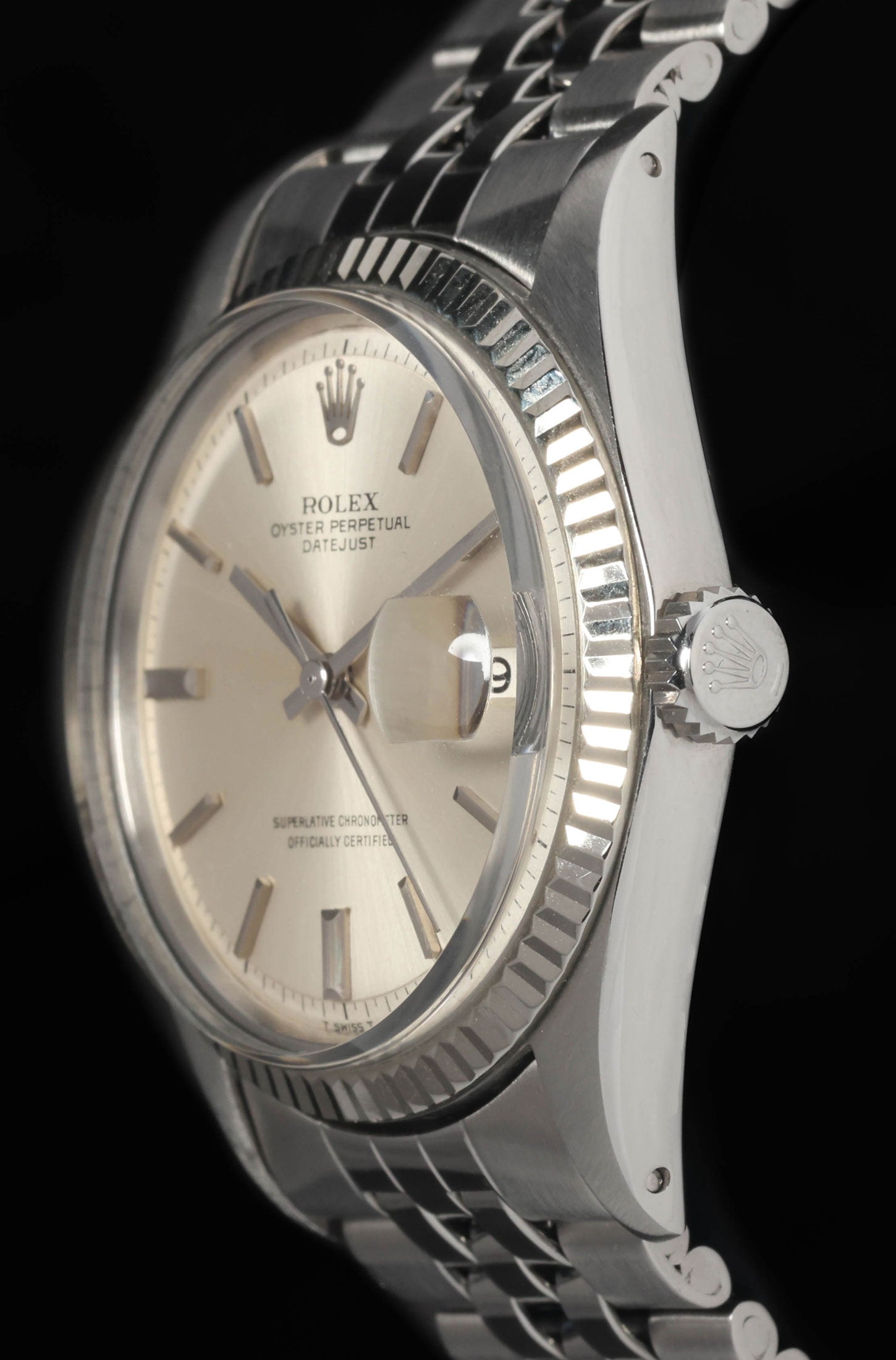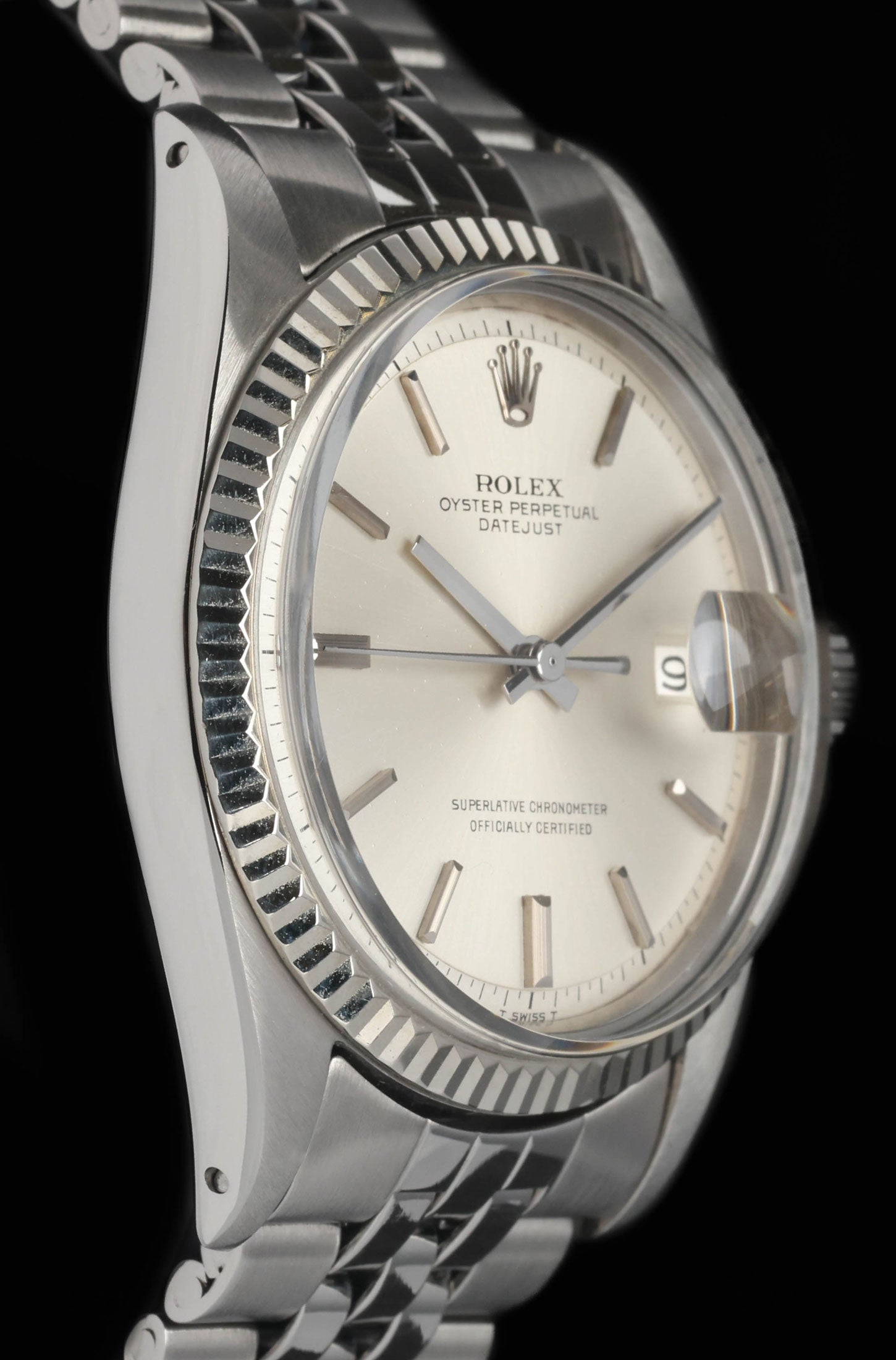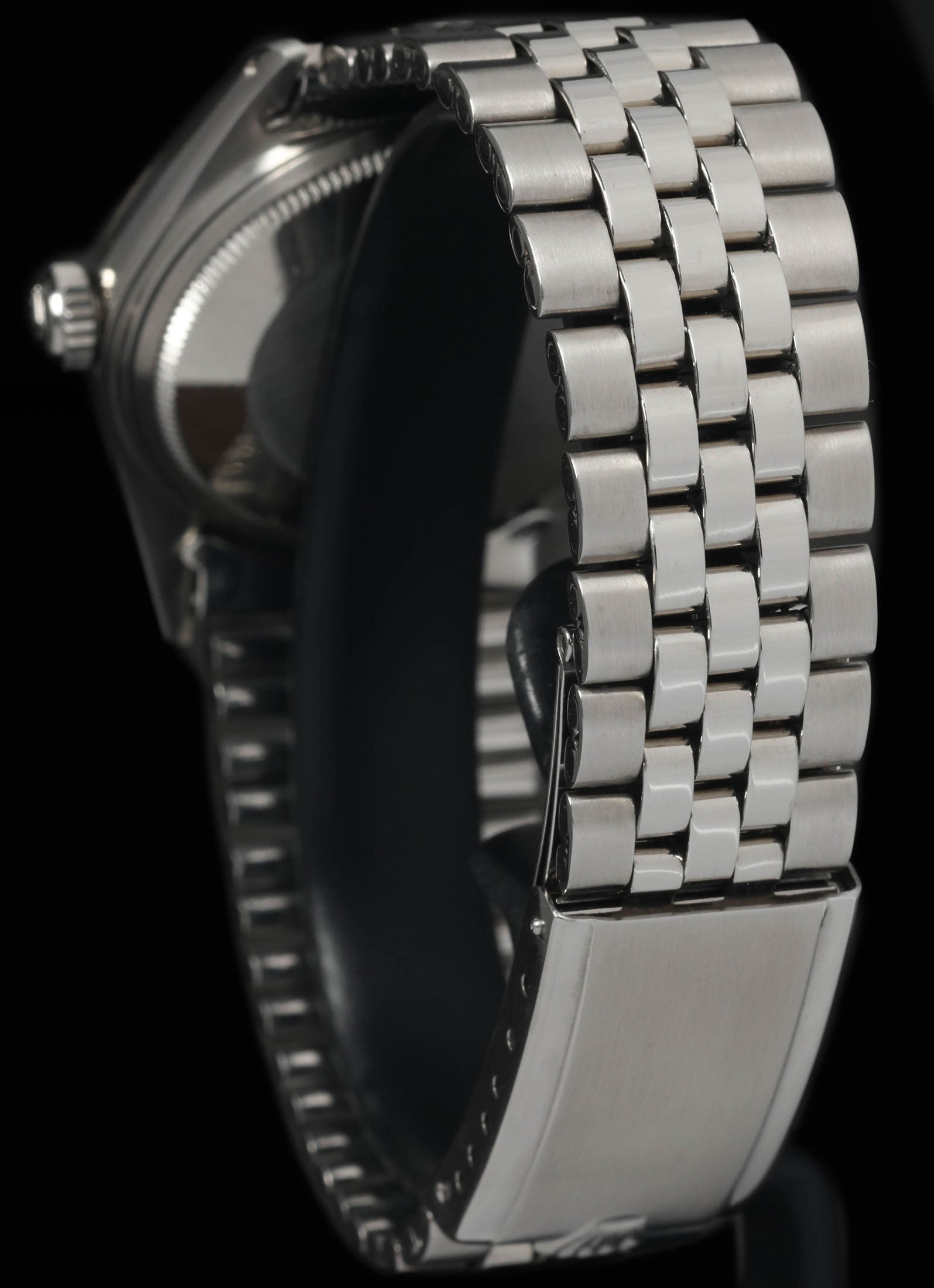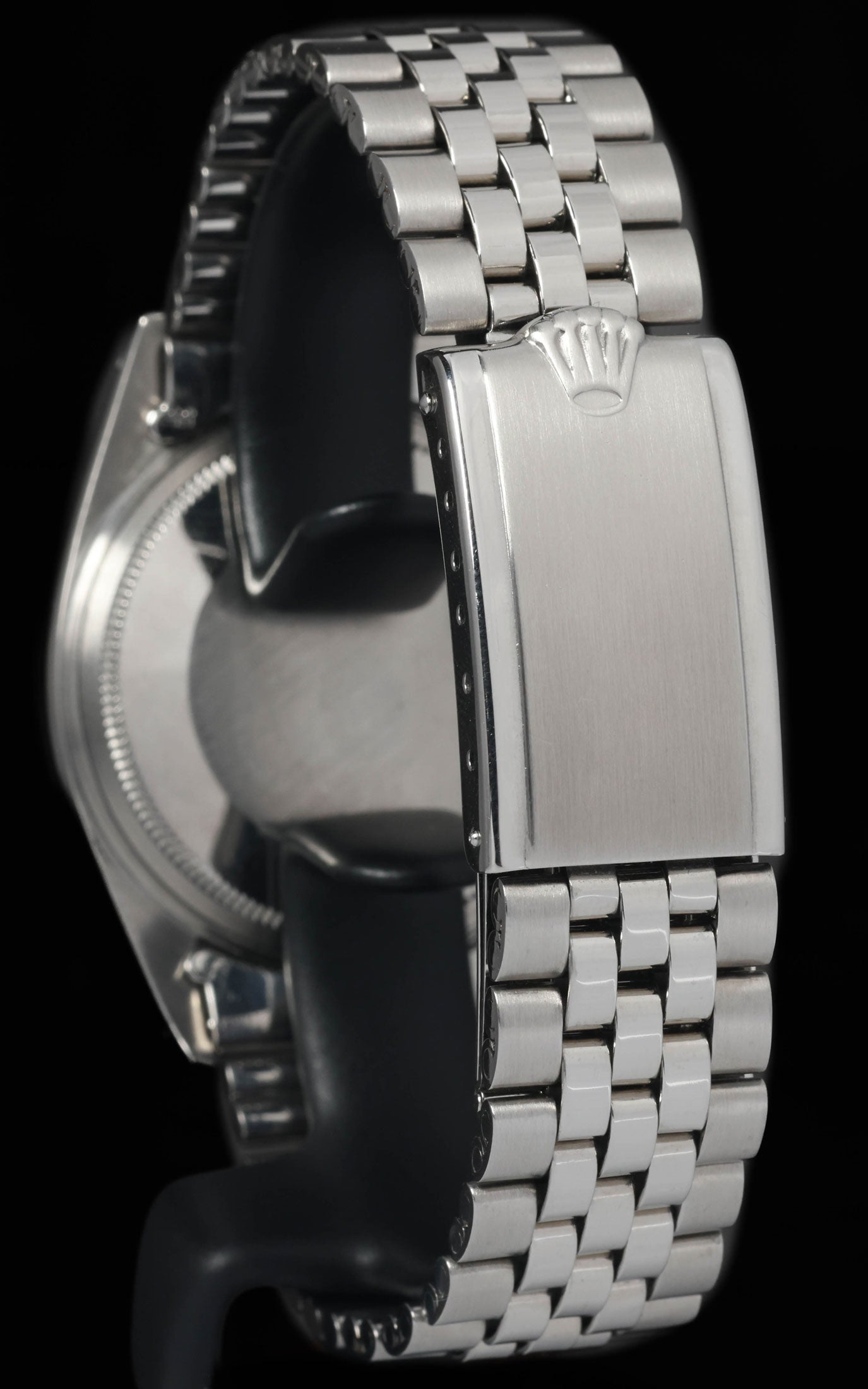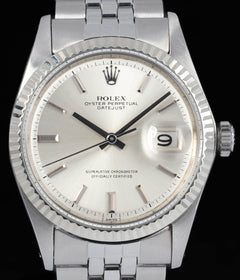Crown Vintage
Rolex Datejust 1601 'Non-Lume Dial' 36mm 1969
Rolex Datejust 1601 'Non-Lume Dial' 36mm 1969
Couldn't load pickup availability
Rolex Datejust 1601 'Non-Lume Dial' 36mm 1969
The case is in very good unpolished condition, retaining its original factory lines and sharp edges. The fluted bezel remains well defined with strong detailing. The bracelet is in excellent condition with only light signs of wear and some stretch consistent with age, maintaining a tight and comfortable fit. The silver dial presents beautifully, with all text crisp and legible. The hands are in very good condition, showing only minimal ageing under close inspection. Overall, this is an exceptionally well-preserved example that remains honest and original, displaying strong definition and outstanding vintage appeal.
Share
Why we love this watch
Why we love this watch
Rolex Datejust 1601 Non-Lume Dial
Introduced in the early 1960s, the 1601 marked the maturity of the Datejust concept. It carried forward the practicality of the early Oyster Perpetuals while adding the elegance of the fluted gold bezel and the precision of Rolex’s 1500-series automatic movements.
Among the many variants of the 1601, few are as quietly distinctive as the non-lume dial version. Produced during the late 1960s, this rare configuration features a dial marked “T Swiss T” yet lacks any luminous material on the hour markers or hands. The result is a minimalist execution that highlights the symmetry and refinement of the design, giving the watch a purity seldom found in other Datejust models of the period.
The Role of the 1601 in Rolex History
By the time the reference 1601 appeared, the Datejust had already become a defining model for Rolex. It was the first self-winding chronometer wristwatch to display a date that changed automatically at midnight, an innovation that fundamentally shaped modern watchmaking. The 1601 refined this concept into what many consider the definitive form of the Datejust: a 36 millimetre Oyster case, a fluted bezel crafted in gold, and the choice of Jubilee or Oyster bracelet.
The 1601 emerged during a period when Rolex was refining its manufacturing processes and aesthetic identity. It was built to last a lifetime, with technical innovations that were practical rather than ornamental. The fluted bezel, the waterproof Oyster case, and the chronometer-certified movement combined to create a watch that could withstand daily wear while maintaining an air of quiet sophistication.
During the 1960s, the Datejust became the default choice for professionals seeking reliability without ostentation. It was a symbol of consistency and integrity, worn by those who valued precision and design over novelty. The 1601 epitomised that philosophy.
Case and Construction
The Oyster case of the 1601 measures 36 millimetres in diameter and is crafted in stainless steel with a solid gold fluted bezel. The proportions are ideal, with balanced lugs and a polished caseband offset by brushed lug tops. The case construction follows the same principles that define modern Rolex watches: a monobloc middle case, screw-down crown, and screw-down caseback. This design offered 100 metres of water resistance when new, making the Datejust as capable as it was elegant.
The fluted bezel remains one of Rolex’s signature design elements. On the 1601, it was executed in either white or yellow gold, adding warmth and light to the steel case. Each flute catches and reflects light at varying angles, creating a dynamic halo around the dial. The acrylic crystal, complete with the magnifying Cyclops lens, adds a softness to the overall profile and introduces a vintage charm absent from modern sapphire-equipped models.
The case’s finishing plays a crucial role in its character. The contrast between the brushed lugs and polished sides defines the watch’s geometry, giving it clarity and structure. Well-preserved examples retain sharp edges and clean transitions, which are highly valued by collectors today.
The Non-Lume Dial
The most fascinating aspect of this version of the 1601 is its dial. It appears at first glance to be a standard Datejust configuration: silver sunburst finish, applied baton markers, the Rolex coronet at twelve o’clock, and the classic date window at three. Yet it lacks any trace of luminous material, despite being signed “T Swiss T” at the bottom edge.
This small inconsistency tells a deeper story about Rolex production during the late 1960s. Dial manufacturing was distributed among several suppliers, including Singer and Beyeler, and minor variations were common. Some batches of dials were printed with standard templates that included the “T Swiss T” signature, even if tritium was not ultimately applied. In other cases, Rolex may have intentionally omitted lume to meet export regulations or customer preferences for markets where non-luminous dials were preferred.
Whatever the reason, the result is visually striking. Without lume plots, the dial achieves perfect symmetry. The hour markers stand unbroken, their polished surfaces uninterrupted by dots of tritium. The effect is cleaner and more formal, allowing the light to move evenly across the radial brushing of the dial. It is a subtle change that transforms the entire character of the watch.
The finish of the dial itself is typical of the era: a fine sunburst silver tone that shifts between shades of white, grey, and metallic champagne under different lighting. The applied baton markers are crisp and faceted, while the printing remains flawless and balanced. “Rolex Oyster Perpetual Datejust” sits confidently at the upper half, and “Superlative Chronometer Officially Certified” is neatly curved above the six o’clock marker. The typography, printing quality, and applied details all reflect the precision of late-1960s Rolex craftsmanship.
Hands and Dial Details
The hands are slender polished batons that mirror the shape of the hour markers. Like the markers, they lack luminous infill, giving them a perfectly clean look. When viewed closely, many examples show light oxidation at the bases of the hands, a natural patina consistent with the watch’s age. This slight ageing complements the soft tones of the dial and bezel, enhancing the vintage appeal without detracting from legibility.
The second hand is a simple, needle-like pointer that sweeps smoothly across the dial, its polished surface catching the light at each rotation. Together, the three hands and applied markers create a dial layout that is calm, legible, and timeless.
Movement and Performance
Inside the 1601 beats the Rolex calibre 1575, part of the brand’s 1500-series family of automatic movements. The calibre 1575 represents the peak of Rolex’s mid-century engineering. It operates at 19,800 vibrations per hour, features 26 jewels, a bi-directional rotor system for efficient winding, and a free-sprung balance regulated by Microstella screws.
The movement incorporates an instantaneous date-change mechanism that advances precisely at midnight. It does not include a quickset feature, meaning the date must be adjusted by rotating the hands through 24-hour cycles. While less convenient than later versions, this manual engagement with the movement adds to the tactile pleasure of operating a vintage watch.
Many examples of the calibre 1575 produced around 1969 include hacking seconds, allowing the wearer to stop the seconds hand for precise time setting. The movement is chronometer-certified, ensuring high accuracy. With proper maintenance, the calibre 1575 remains capable of excellent performance decades after it left the factory.
Its architecture is robust, designed for longevity. The bridges are solid, the rotor is heavy and reliable, and the gear train is engineered for minimal friction. These qualities have made the 1575 one of Rolex’s most respected calibres, both among collectors and watchmakers.
Bracelet and Wearability
The 1601 was most commonly paired with the Jubilee bracelet, a five-link design that perfectly complements the refined character of the Datejust. Its polished centre links and brushed outer links echo the alternating finishes of the case, creating visual harmony. The bracelet’s flexibility makes it exceptionally comfortable, draping naturally around the wrist.
An alternative configuration was the Oyster bracelet, whose three-link construction lends a slightly sportier, more utilitarian feel. Both styles are correct for the period and change the personality of the watch subtly. The Jubilee accentuates its elegance, while the Oyster enhances its versatility.
On the wrist, the 36 millimetre case wears beautifully. It feels substantial but never heavy, and the proportions are perfectly judged. The fluted bezel catches light with every movement, and the acrylic crystal gives a gentle distortion that enhances the sense of depth on the dial. The combination of silver dial, polished hands, and white gold bezel results in a watch that is both understated and visually dynamic.
The Absence of Lume
The absence of lume is more than a technical curiosity; it represents a distinct aesthetic statement. Without luminous plots or infill, the dial achieves a level of balance that makes it feel almost architectural. The polished markers reflect light evenly, the dial’s radial brushing remains uninterrupted, and the composition gains an added sense of calm precision.
This non-lume design also affects how the watch has aged. While tritium dials from the same era often show discolouration or spotting, non-lume dials tend to remain cleaner and more uniform. As a result, many examples retain their original brightness even after fifty years. This makes the non-lumed 1601 particularly attractive to collectors who value originality and visual purity.
It also offers a rare glimpse into Rolex’s production flexibility during the period. Although the company is now known for its absolute consistency, vintage pieces like this reveal that there was once room for small variations. These details give each watch personality and individuality.
Comparison within the 16xx Series
The 1601 sits at the centre of the Datejust family of the 1960s and 1970s. The 1600 featured a smooth steel bezel, creating a modern and minimal aesthetic. The 1603 offered an engine-turned steel bezel with an industrial character. The 1601, with its fluted gold bezel, achieved a balance between sport and sophistication.
This mixture of steel and gold became the hallmark of the Datejust. It gave the watch versatility unmatched by pure steel or gold models. The 1601 could be worn every day yet remained suitable for formal occasions. It was a watch for all circumstances, embodying the Rolex ideal of functional luxury.
The non-lume variant enhances this versatility further. It strips the dial of any visual noise, letting the materials and geometry speak for themselves. The result is a composition that feels timeless, an object of design that transcends trends.
Transitional Features and Production Context
The 1601 belongs to an era when Rolex was perfecting both its engineering and its aesthetic identity. It represents the culmination of decades of incremental refinement. The 1500-series movements were reaching their zenith, and Rolex was beginning to standardise many of the design elements that define its modern watches.
The non-lume dials appeared primarily in the late 1960s and early 1970s, likely as transitional or limited-production variants. They are associated with the period immediately before Rolex introduced the quickset 3035 movement in the late 1970s. The acrylic crystal, drilled lugs, and folded-link bracelets of this generation mark the end of an era in which mechanical watchmaking still bore the traces of handcraftsmanship.
Aesthetic Character and Presence
The 1601 with non-lume dial possesses a calm, composed aesthetic that few watches can match. Under natural light, the silver dial reveals fine gradations of tone, shifting gently as the wrist moves. The faceted markers and polished hands catch light in precise highlights, giving the dial subtle motion. In dimmer light, the watch takes on a quiet, monochromatic beauty.
This interplay of form, proportion, and light defines the appeal of the 1601. It is not a loud watch; it is one that rewards attention. Every detail contributes to the sense of balance. The fluted bezel, the restrained typography, and the symmetry of the non-lume markers all work together to create a coherent whole.
In an era of oversized sports watches and complex dials, the 1601 stands as a reminder of the power of simplicity. It is a watch that achieves elegance through restraint, a quality that continues to define Rolex at its best.
Final Thoughts
The Rolex Datejust 1601 with non-lume dial is a rare and captivating variant of one of the most important watch designs of the twentieth century. It encapsulates the enduring qualities that make Rolex unique: precision, restraint, and craftsmanship. Its 36 millimetre Oyster case, fluted gold bezel, and silver sunburst dial form a composition that has never gone out of style.
The lack of luminous material gives this version a distinctive clarity. It allows the surfaces, finishes, and proportions to shine without distraction. It also preserves the dial’s condition, ensuring that it retains its original character decades after production.
Case & Bracelet
Case & Bracelet
Case in very good unpolished condition. Bracelet in excellent condition. Some stretch consistent with age.
Dial & Hands
Dial & Hands
Dial and hands are in very good condition.
Warranty & Condition
Warranty & Condition
Crown Vintage Watches provides a minimum 3-month mechanical warranty on pre-owned watches, from the date of purchase.
The warranty covers mechanical defects only.
The warranty does not cover damages such as scratches, finish, crystals, glass, straps (leather, fabric or rubber damage due to wear and tear), damage resulting from wear under conditions exceeding the watch manufacturer’s water resistance limitations, and damage due to physical and or accidental abuse.
Please note, water resistance is neither tested nor guaranteed.
Shipping and insurance costs for warranty returns to us must be covered by the customer. Returns must be shipped via traceable courier. Return shipment must be pre-paid and fully insured. Collect shipping will be refused. In case of loss or damages, the customer is liable.
Our Pledge
At Crown Vintage Watches, we stand by the authenticity of every product we sell. For added peace of mind, customers are welcome to have items independently authenticated at their own expense.
Condition
Due to the nature of vintage timepieces, all watches are sold as is. We will accurately describe the current condition and working order of all watches we sell to the best of our ability.
Shipping & Refund
Shipping & Refund
